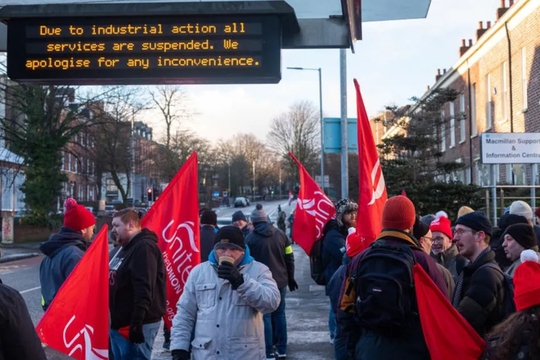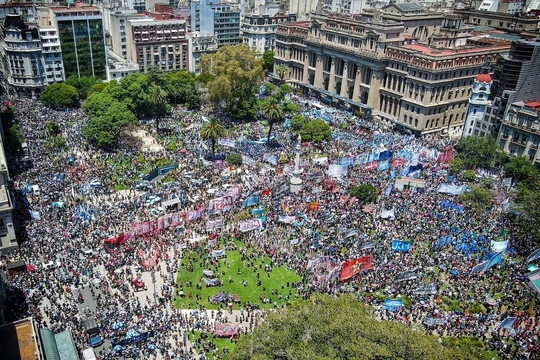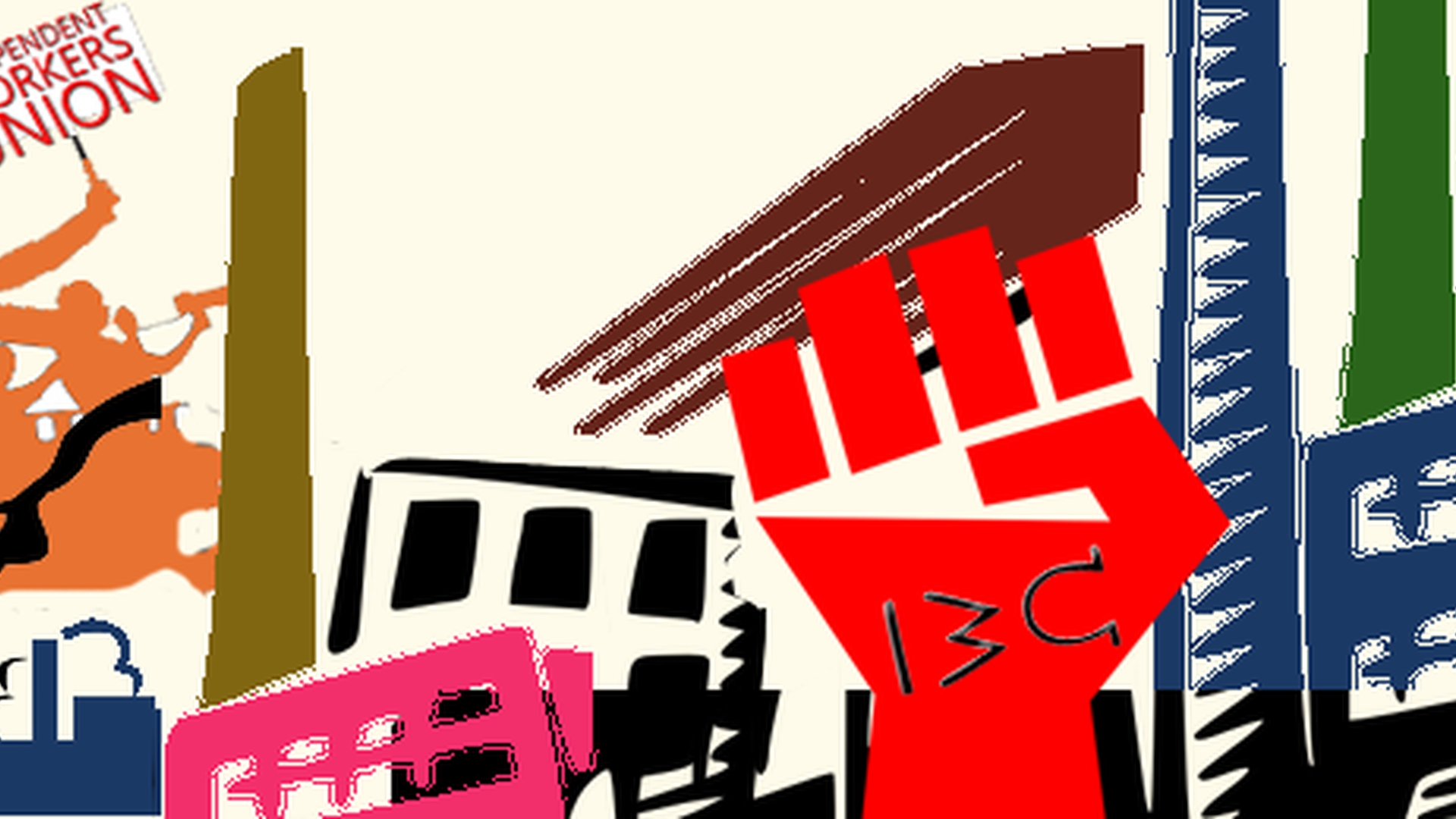Strike Action Unites Northern Ireland
by
Pádraig de Cléir
April 24, 2024
Featured in Struggling to Work (#20)
On Thursday 18th January 2024, over 150,000 workers in the North of Ireland’s public sector downed tools. In this article, Pádraig de Cléir - a teacher in West Belfast who took part in this strike - looks at the lessons we can learn from this strike that spanned across industries and communities, merging political and economic demands.

inquiry
Strike Action Unites Northern Ireland
by
Pádraig de Cléir
/
April 24, 2024
in
Struggling to Work
(#20)
On Thursday 18th January 2024, over 150,000 workers in the North of Ireland’s public sector downed tools. In this article, Pádraig de Cléir - a teacher in West Belfast who took part in this strike - looks at the lessons we can learn from this strike that spanned across industries and communities, merging political and economic demands.
Thursday 18th January saw huge numbers of workers from across Northern Ireland’s1 public sector out on strike together. Nurses, cleaners, cooks, administrators, transport workers, civil servants, road gritters, my fellow teaching colleagues and others from sixteen striking unions gathered together and picketed our workplaces across the province, bringing it to an effective standstill. After ensuring our workplaces’ closure, workers here in Belfast sporting every colour of flag, banner and placard gathered at each of the hospitals posted around the edges of the city centre and we marched together in our thousands toward the rally at city hall. Over 150,000 workers, representing around a fifth of Northern Ireland’s working population, participated in the greatest mobilisation of industrial action the region has seen in at least fifty years. The strike brought workers from all backgrounds together, and marks a proud new chapter in community relations, as well as working class consciousness, that stands in sharp contrast to the festival of sectarian violence that was the Ulster Workers’ Council strike of 1974. Our demands are yet to be met, but our action is catalysing change.
Public Services Neglected
Public sector workers have gone years without a rise in pay and our frustration has grown as the government has made derisory pay offers dwarfed by the rate of inflation. Settlements for public sector workers in Britain after their successful strikes have served to highlight the growing disparities across the ‘United Kingdom’. The starting salary for a nurse in Northern Ireland is £27k, whereas over the water in Scotland nurses start on £30k. The contrast for us teachers is even starker, with a starting salary of £24k in Northern Ireland, compared to £32k in Scotland, and just over the border, teachers in the Republic of Ireland start on £37k. You can imagine the challenge this presents to schools in border towns.
Pay is the headline issue that our unions have rightly rallied around, but in truth Northern Ireland is experiencing an omni-crisis, and workers could have justifiably gone on strike for any number of reasons. Public services are in freefall, with hospital waiting times in Northern Ireland, already by far the highest in the UK, increasing enormously since the pandemic. There are currently over half a million cases on waiting lists in a region with a population of under two million. Due to budget cuts, no school buildings will be built during this school year, despite large numbers of schools operating out of prefabs. School children’s rate of chronic absence is a staggering 30%. Symptomatic of the statelet’s decay was Lough Neagh’s bacterial bloom, that this summer turned these islands’ largest freshwater lake - and the source of Belfast’s drinking water - into a stinky, green sludge, toxic to life. There are several contributing factors to this environmental crisis, but chief among them is that checks on farms’ slurry discharges have not been taking place, and with an over-stretched civil service, until recently lacking a sitting government, there is a lack of leadership to make change to prevent this happening again this coming summer.
Long-Term Political Instability
In the lead up to the strike, Northern Ireland had spent two years running on zombie mode as the Democratic Unionist Party had refused to nominate a deputy First Minister, which would allow the devolved assembly to sit and govern. This in protest at the government’s post-Brexit trade settlement with the EU which they say erodes their Britishness, due to a degree of differentiation between trade rules in Northern Ireland and Britain. Adding to the DUP’s anxiety has been the surge of Sinn Féin who, over the last two years, have become the party with the highest number of representatives in both the assembly and in local government. Nationalist parties recently gained a higher vote share than unionist parties for the first time ever, and calls for preparation for a border poll to unite Ireland are louder than ever before. For the devolved government to operate, the consent of the largest nationalist and unionist parties is required and this sectarianism, codified in the Good Friday Agreement, has resulted in the Assembly being in a state of collapse for 40% of its existence. Although political stasis is nothing new here, this time has been different.
Previous Stormont collapses occurred due to issues that mattered to everyone – paramilitary decommissioning, policing, political mismanagement – and importantly, this nascent political process was born of a decree of goodwill following decades of political violence. The DUP’s attempts to reignite mass loyalist street protests against the Northern Ireland Protocol have faltered, but in 2024, a lack of violence is not good enough for people struggling to pay rising rents and fuel bills. A degree of faith has been lost in the parliamentary political process arising out of the attempts of Northern Ireland’s Secretary of State in Westminster, Chris Heaton-Harris, to cajole the DUP back into government through the carrot and stick of bribery and punishment budgets. Workers left their places of work knowing that money had been made available by Westminster for the purpose of public sector pay rises, knowing that workers in Britain have received rises after going on strike, and knowing that our pay was being held to ransom in a power play between the Tories and the DUP.
The unions’ anger toward the Secretary of State was made clear at the Belfast rally. Speaker after speaker focused their ire on Heaton-Harris and on ‘Westminster’, expressing a sentiment of frustration at being ruled by a party and an institution that almost no one in the region votes for. The speeches were enthusiastic, if not somewhat formulaic, but they showed an apparent lack of coordination between the leaders of the sixteen unions, wheeled out in turn and congratulated by the MC when they stuck to their three minutes. With a couple of exceptions, speakers seemed reluctant to use their leverage and call out the DUP, satisfied perhaps to castigate the Tory villain from afar, rather than risk turning off a potential constituency of dues-payers. Although the rallies in Belfast and in several other towns around the region were well attended, a ‘no-travel’ warning due to ice, snow and the road gritters’ strike reduced numbers. Prior to the strike Patrick Mulholland, the leader of the public services union NIPSA, had called for a campaign of civil disobedience to complement strikes and force the government’s hand on funding for public services, but neither the groundwork nor the requisite spark of anger that would allow for bolder action were present on the day. Nonetheless, the atmosphere in Belfast was one of pride, defiance, and determination. By the end of the month, our collective action had helped force the DUP to get back into government to make a deal.
The Path Toward Strike Action
The build up to this mass, coordinated strike action has been years in the making. The public sector pension strike of 2015 included only five of the 16 unions that went out on Thursday 18th. Back then INTO was the only teachers’ union that was out, but watching our pay deteriorate and seeing sector after sector in Britain and Ireland join pickets has emboldened comrades in other unions. The more conservative Ulster Teachers Union went on strike for the first time last year, and this has allowed for unprecedented coordination between the four unions representing teachers here for several single-day teacher strikes over the last year.
Six months prior to commencement of strike action, the INTO began action short of strike. At the time, there was doubt among teachers in my school about suspending regular meetings and other non-core tasks. It was expected that this would cause disruption to the kids and could therefore impact our working conditions, without mounting any pressure on the government to address our pay. In hindsight, this action has been worthwhile and effective in creating a union culture - showing that the union has strength in creating changes to workplace practice, motivating new members of staff to join the union, reminding everyone that we are in dispute over pay.
Single-day actions by individual unions have been well-supported and well-adhered to by members. Teacher strikes have succeeded in shutting just about every school, bar the odd one or two kept operating in name only by an odd, stubborn principal. Strikes have increased union membership and helped with political education. In November, a Unison shop steward comrade of mine, who had organised a picket of teaching assistants, expressed frustration with other school workers who crossed the picket line rather than going around to enter the school through the other side of the building, as had been agreed between the respective unions. Since then the school’s teachers, assistants, cooks, cleaners, admin and premises staff have all stood on the same picket and communication and understanding has improved between groups who have often been siloed.
The Political Atmosphere on the Ground
After spending a number of years working and doing union-organising in London under the Tories’ anti-strike laws, I was interested to note the relative assuredness in Belfast trade unionism. In England fears over falling short of the ballot threshold had led to anxiety and disunity among comrades, even regarding calls for an indicative ballot. I felt frantic at times as a union rep running around school, asking members once more to update their addresses with head office to make sure we got the numbers. In the end the thresholds prevented NASUWT from joining NEU in their successful strike action in England last year, despite their membership being overwhelmingly in favour of going on strike. Action short of strike didn’t seem like a realistic tactic given the pressured, competitive work culture fostered by many academy schools, particularly in London.
In terms of political culture, I have to pay tribute to west Belfast. All along the Falls Road socialism is celebrated through political murals featuring, among others: Kurdish freedom fighters, Cuban revolutionaries, and our local hero, James Connolly. Students in my own school make their way to lessons through corridors adorned with murals devoted to women rebels such as Angela Davis and Bernadette Devlin. Their principled outlook has been adopted by the kids themselves, who have in recent months been staging regular lunchtime demonstrations in solidarity with the oppressed people of Palestine. The Connolly café opposite our school’s picket line offers discounted meals for striking workers and on the 18th, staff who were gathered at the Royal Hospital picket were treated to free breakfast baps and hot drinks by Food Not Bombs as well as carnival music provided by a local samba band who gathered to set the pace for the march. Organising is easier in such an atmosphere.
Future Prospects
Subsequent to the return of the devolved government, our unions have been allowing some time and space for a deal to be done. However, after such a protracted process involving so many political tricks, we are weary of letting up on the pressure. Heaton-Harris has recently indicated that money promised for a pay deal will now only be released if austerity measures are implemented, such as new water charges. Since 18th January transport workers have already taken four days of strike action and they have announced another three days. Junior doctors have announced a first day of strike action and teachers’ unions have indicated their intention to come out again.
Unless the pay issue is sorted soon, other unions are also sure to continue to organise and coordinate through the Irish Congress of Trade Unions. That so many sectors have gone on strike at the same has linked all our struggles and shielded us from the snarky, divisive commentary that is typically fostered by the media during times of industrial action, and there is broad public support for our strikes. Whether or not an appetite for more sustained strikes is developed depends in large part on how soon and how generous pay deals can be made. However, given the increased costs of living, rising rent and low levels of pay, some workers, such as teaching assistants, may not feel able to afford to lose a week’s wages at a time without resorting to union hardship funds.
Northern Ireland’s public sector strikes have given workers a sense of hope and pride at a time when parliamentary politics has clearly been failing. The working-class consciousness that has been built through action is the perfect antidote to sectarian division and the British workers’ pay settlements have had a notable effect here, with pay parity with the British an ambition shared by all. The strikes have made clear the power that workers have, particularly in key infrastructural sectors. The road gritters’ strike was able to finally shut Queen’s University down where prolonged strike action by UCU members had unfortunately failed to do so. A revolutionary consciousness is unlikely to be developed in Northern Ireland due to the release valve that the prospect of a border poll holds out, but this DUP doomsday scenario should at least be enough to pressure those in power to give in to our demands and try and make the statelet work before workers develop other ideas.
-
NFB editors’ note: it is our usual house-style to use the term ‘North of Ireland’ when referring to the British-occupied six counties. However, it was the author’s choice in this article to use the term “Northern Ireland”, which we have respected when publishing. ↩
Featured in Struggling to Work (#20)
author
Pádraig de Cléir
Subscribe to Notes from Below
Subscribe now to Notes from Below, and get our print issues sent to your front door three times a year. For every subscriber, we’re also able to print a load of free copies to hand out in workplaces, neighbourhoods, prisons and picket lines. Can you subscribe now and support us in spreading Marxist ideas in the workplace?
Read next


